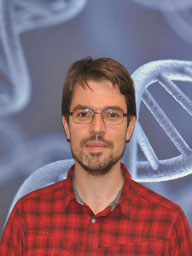Ingo TewsCNLS Postdoctoral Research Associate
T-2/CNLS Theoretical nuclear physics and neutron stars 
Office: TA-3, Bldg 1690, Room 121
Mail Stop: B283
Phone: (505) 665-7618
Fax: - itews@lanl.gov
home page Research highlight- Local chiral effective field theory interactions
- Neutron-rich matter equation of state and light nuclei
- Nuclear astrophysics, neutron stars and neutron-star mergers
- Quantum Monte Carlo methods
|  | Educational Background/Employment:- B.Science, Physics (2010) - Technische Universitaet Darmstadt, Germany
- M.Science, Physics (2012) - Technische Universitaet Darmstadt, Germany
- PhD, Physics (2015) - Technische Universitaet Darmstadt, Germany
- Employment:
- 2012-2015 Graduate Research Associate at Technische Universitaet Darmstadt,
Darmstadt, Germany
- 2015-2018 Postdoctoral Research Associate at the Institute for Nuclear Theory,
Seattle, Washington, USA
Research Interests: - Neutron stars are astrophysical objects of extremes. They contain the largest
reservoirs of degenerate fermions, reaching the highest densities we can observe in the cosmos, up
to 10^15 g/cm^3 in their core. Neutron stars represent an exciting testing ground for predictions
of strongly interacting matter; they exhibit fascinating phenomena like nucleon superfluidity or
possible exotic matter in their core. In August 2017, the first neutron-star merger has been
observed, which provided compelling evidence that these events are an important site for the
production of extremely neutron-rich nuclei at the limit of nuclear existence within the r-process,
and therefore, of elements heavier than iron here on Earth. Because these neutron-rich nuclei play
a critical role in the evolution of stars and in nucleosynthesis, they present fascinating systems
to study both for theory and experiment, and will be probed in new radioactive beam facilities
like the FRIB facility at MSU. In addition, the physics of neutron matter is fascinating in the
regime of extremely low densities, where neutron matter exhibits universal properties that can be
probed in experiments with ultracold atoms.
My research uniquely connects these different density regimes, from nuclei to neutron stars, using
chiral effective field theory (EFT) and advanced many-body methods. Chiral EFT provides a systematic
approach to nuclear interactions and allows calculations with controlled theoretical uncertainties.
It explicitly includes chiral physics, which connects the EFT with the theory of Quantum Chromodynamics.
Chiral EFT also predicts consistent many-body interactions. Studies of three-body forces, ranging from
Efimov physics to exotic nuclei, are a major frontier in nuclear physics. Moreover, chiral EFT has
been successfully used to calculate electroweak processes and the interactions of dark matter particles
with nuclei. I use Chiral EFT and advanced many-body methods to provide a consistent and systematic
approach to strong interactions and to carry out precision studies of nucleonic matter and of nuclei
with controlled theoretical uncertainties. Currently, I study the binding of light nuclei, the
equation-of-state (EOS) of nucleonic matter, and gravitational waves from neutron-star mergers. These
studies are critical for the understanding of the physics of neutron-rich nuclei probed in the new FRIB
facility, and for the nuclear astrophysics of neutron stars and neutron-star mergers, which were
recently detected by the Advanced LIGO facility.
Selected Recent Publications: Full publication list on Inspire: here.
- IT, J. Margueron, S. Reddy, Confronting gravitational-wave observations with modern nuclear physics constraints, arXiv:1901.09874.
- IT, J. Margueron, S. Reddy, Critical examination of constraints on the equation of state of dense matter obtained from GW170817, Phys. Rev. C 98, 045804 (2018), Editor's Suggestion.
- IT, J. Carlson, S. Gandolfi, S. Reddy Constraining the speed of sound inside neutron stars with chiral effective field theory interactions and observations, Astrophys. J. 860, 149 (2018).
- J.E. Lynn, IT, J. Carlson, S. Gandolfi, A. Gezerlis, K.E. Schmidt, A. Schwenk Quantum Monte Carlo calculations of light nuclei with local chiral two- and three-nucleon interactions, Phys. Rev. C 96, 054007 (2017), Editor's Suggestion.
- IT, J.M. Lattimer, A. Ohnishi, E.E. Kolomeitsev Symmetry Parameter Constraints from a Lower Bound on the Neutron-matter Energy, Astrophys. J. 848, 105 (2017).
- J.E. Lynn, IT, J. Carlson, S. Gandolfi, A. Gezerlis, K.E. Schmidt, A. Schwenk Chiral Three-Nucleon Interactions in Light Nuclei, Neutron-α Scattering, and Neutron Matter, Phys. Rev. Lett. 116, 062501 (2016).
- A. Gezerlis, IT, E. Epelbaum, S. Gandolfi, K. Hebeler, A. Nogga, A. Schwenk Quantum Monte Carlo calculations with chiral effective field theory Interactions, Phys. Rev. Lett. 111, 032501 (2013).
- IT, T. Krueger, K. Hebeler, A. Schwenk Neutron matter at next-to-next-to-next-to-leading order in chiral effective field theory, Phys. Rev. Lett. 110, 032504 (2013).
|

